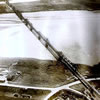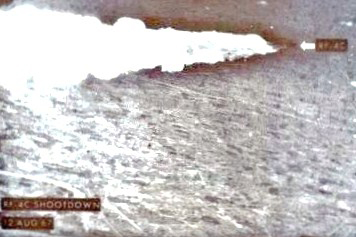Downtown and Other Places in Harm’s Way
Sometimes the target is you--sometimes it's them
Jimmy Stewart visits, Gustav Eiffel's Bridge is falling down.
This slide show starts and advances automatically; or you may control it manually with the buttons and controls below.
Move
 |
 Ed Atterberry and Tom Parrot in RF-4C 65-0882 about one second after a SAM has exploded in close proximity—as designed—to their airplane; date: 12 August 1967. Both were captured; Ed was later beaten to death by the North Vietnamese and Tom was repatriated with the other POWs (see “How They Brought the Good News from Ghent to Aix” in Alone, Unarmed and Unafraid). (Photo credit: Lee (last name unknown) and Frank Doyle; U.S. Air Force; library of Dick Hammaker; used by permission.)
Ed Atterberry and Tom Parrot in RF-4C 65-0882 about one second after a SAM has exploded in close proximity—as designed—to their airplane; date: 12 August 1967. Both were captured; Ed was later beaten to death by the North Vietnamese and Tom was repatriated with the other POWs (see “How They Brought the Good News from Ghent to Aix” in Alone, Unarmed and Unafraid). (Photo credit: Lee (last name unknown) and Frank Doyle; U.S. Air Force; library of Dick Hammaker; used by permission.) Jimmy Stewart, a brigadier general in the U.S. Air Force Reserve, visits Udorn in this undated photograph taken in the squadron flight planning room. There are several quiet statements being made: the one star is standing between Stewart and the (presumably) photographs of previous successes; only one flight crew member—well, a flight suit—is in the picture; the grey-haired guy on the far right appears to wish all this was over. According to the officer’s club serving staff, Stewart drank whiskey sours; this is not verified. (Photo credit: library of Don Cowdrey; used by permission.)
Jimmy Stewart, a brigadier general in the U.S. Air Force Reserve, visits Udorn in this undated photograph taken in the squadron flight planning room. There are several quiet statements being made: the one star is standing between Stewart and the (presumably) photographs of previous successes; only one flight crew member—well, a flight suit—is in the picture; the grey-haired guy on the far right appears to wish all this was over. According to the officer’s club serving staff, Stewart drank whiskey sours; this is not verified. (Photo credit: library of Don Cowdrey; used by permission.) Four more views of the Paul Doumer Bridge linking China to Hanoi follow. All rail traffic from north of the Red River (read: China and the Soviet Union) to Hanoi had to pass over this bridge. The bridge was on the Do Not Bomb List until 11 August 1967; per news accounts of the era, bombing approval had to come personally from President Johnson (see “How They Brought the Good News From Ghent to Aix” in Alone, Unarmed and Unafraid). (Photo credits: Wikipedia.)
Four more views of the Paul Doumer Bridge linking China to Hanoi follow. All rail traffic from north of the Red River (read: China and the Soviet Union) to Hanoi had to pass over this bridge. The bridge was on the Do Not Bomb List until 11 August 1967; per news accounts of the era, bombing approval had to come personally from President Johnson (see “How They Brought the Good News From Ghent to Aix” in Alone, Unarmed and Unafraid). (Photo credits: Wikipedia.) Paul Doumer Bridge. (Photo credit: Wikipedia.)
Paul Doumer Bridge. (Photo credit: Wikipedia.) Paul Doumer Bridge. (Photo credit: Wikipedia.)
Paul Doumer Bridge. (Photo credit: Wikipedia.) Paul Doumer Bridge. (Photo credit: Wikipedia.)
Paul Doumer Bridge. (Photo credit: Wikipedia.)![050503-F-1234P-023[1]](p7ssm_img_4/thumbs/050503-F-1234P-023[1]_tmb.jpg) Paul Doumer Bridge, 11 Aug 1967, after it was bombed for the first time. This photograph, taken from aircraft commanded by Lieut. Cols Hotchkiss & Place (see "How They Brought the Good News from Ghent to Aix" in Alone, Unarmed and Unafraid) was forwarded to President Johnson, et al., and confirmed the bombers (F-105s) had done their job. (Photo credit: U.S. Air Force; Wikipedia.)(For unknown reasons photo interpreters inserted the date 12 August 1967 in the picture .)
Paul Doumer Bridge, 11 Aug 1967, after it was bombed for the first time. This photograph, taken from aircraft commanded by Lieut. Cols Hotchkiss & Place (see "How They Brought the Good News from Ghent to Aix" in Alone, Unarmed and Unafraid) was forwarded to President Johnson, et al., and confirmed the bombers (F-105s) had done their job. (Photo credit: U.S. Air Force; Wikipedia.)(For unknown reasons photo interpreters inserted the date 12 August 1967 in the picture .)-Laos_tmb.jpg) A Royal Laotian Air Force T-28 taxis at Long Tieng, Laos (more on the role of T-28s in “Colonel Wing Commander” in Alone, Unarmed and Unafraid). Long Tieng (there are multiple spellings) was also known as Lima Site 20A (LS20A), General Vang Pao, commanding. As recently as 2009, General Pao was living in the U.S. (Photo credit: Wikipedia.)
A Royal Laotian Air Force T-28 taxis at Long Tieng, Laos (more on the role of T-28s in “Colonel Wing Commander” in Alone, Unarmed and Unafraid). Long Tieng (there are multiple spellings) was also known as Lima Site 20A (LS20A), General Vang Pao, commanding. As recently as 2009, General Pao was living in the U.S. (Photo credit: Wikipedia.) The A7-71 split. The location is not certain; that said, the location is Laos, possibly southern Laos. The legend on flying maps coded these as all-weather roads. The bomb craters—they appear as scars—are good indicators Air Force target planners considered the roads, especially because of the intersection, worthy targets. By 1970, aircraft, even while bombing, were prohibited from flying below 4,000 feet above ground level while in harm’s way; no target was considered of sufficient value to merit even the possible loss of an aircraft and the maximum range of small arms fire was about 4,000 feet. In context, a .22 caliber rifle would be considered small arms. (Photo credit: library of Dick Hammaker; used by permission.)
The A7-71 split. The location is not certain; that said, the location is Laos, possibly southern Laos. The legend on flying maps coded these as all-weather roads. The bomb craters—they appear as scars—are good indicators Air Force target planners considered the roads, especially because of the intersection, worthy targets. By 1970, aircraft, even while bombing, were prohibited from flying below 4,000 feet above ground level while in harm’s way; no target was considered of sufficient value to merit even the possible loss of an aircraft and the maximum range of small arms fire was about 4,000 feet. In context, a .22 caliber rifle would be considered small arms. (Photo credit: library of Dick Hammaker; used by permission.)

